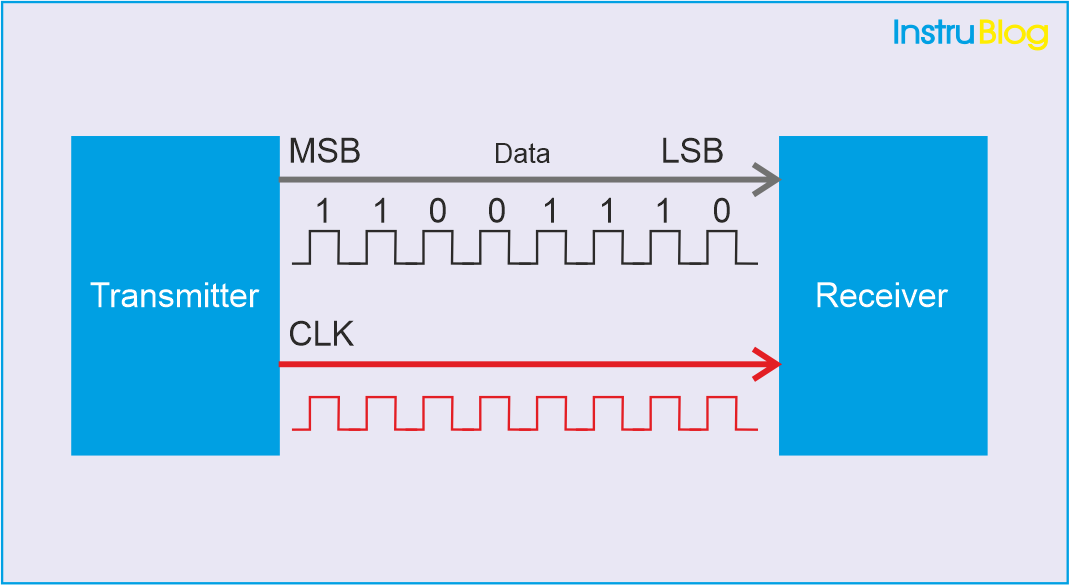What is Serial Communication?
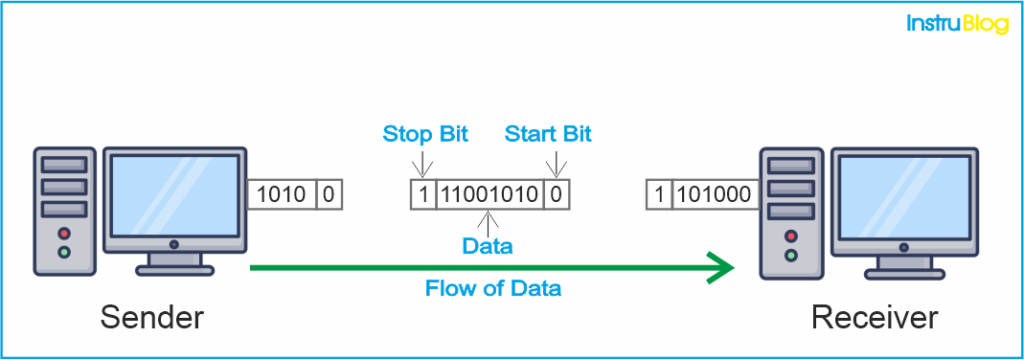
Serial communication is a method of transmitting data between devices using a single data line.
It involves sending bits of data sequentially, one after another, over a communication channel. This can be done using various protocols and standards, such as RS232, RS422, RS485, UART, or SPI.
Serial communication is commonly used in computer peripherals, embedded systems, industrial automation, and many other applications where devices need to exchange data reliably and efficiently.
Types of Transmission Modes
In serial communication, data is transferred by encoding it into binary pulses. The transmission modes used in serial communication are Simplex, Half Duplex, and Full Duplex.
Simplex Method
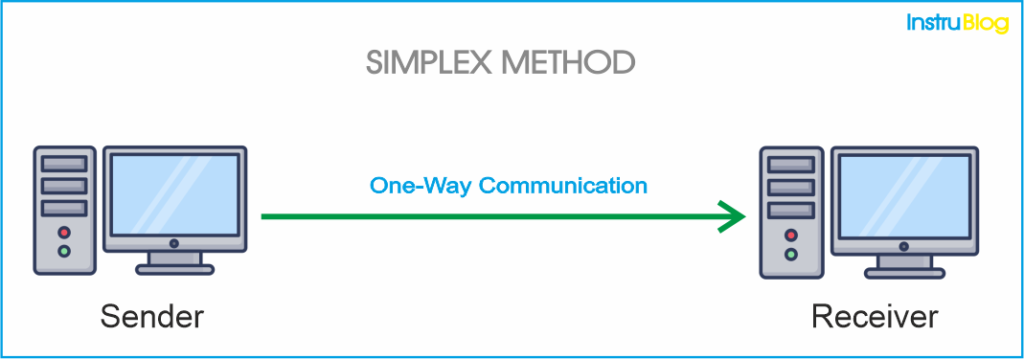
This method is a unidirectional or one-way communication method. It allows data to flow in only one direction at a time.
In this type of communication, if a sender transmits data, the receiver can only receive the data and cannot transmit any response back. This ensures that communication occurs in a single direction.
Examples of this type of communication method include radio broadcasting and television transmission, where the content is sent from the broadcasting station to multiple receivers who can only receive the information but cannot send any data back to the sender.
Half Duplex Method
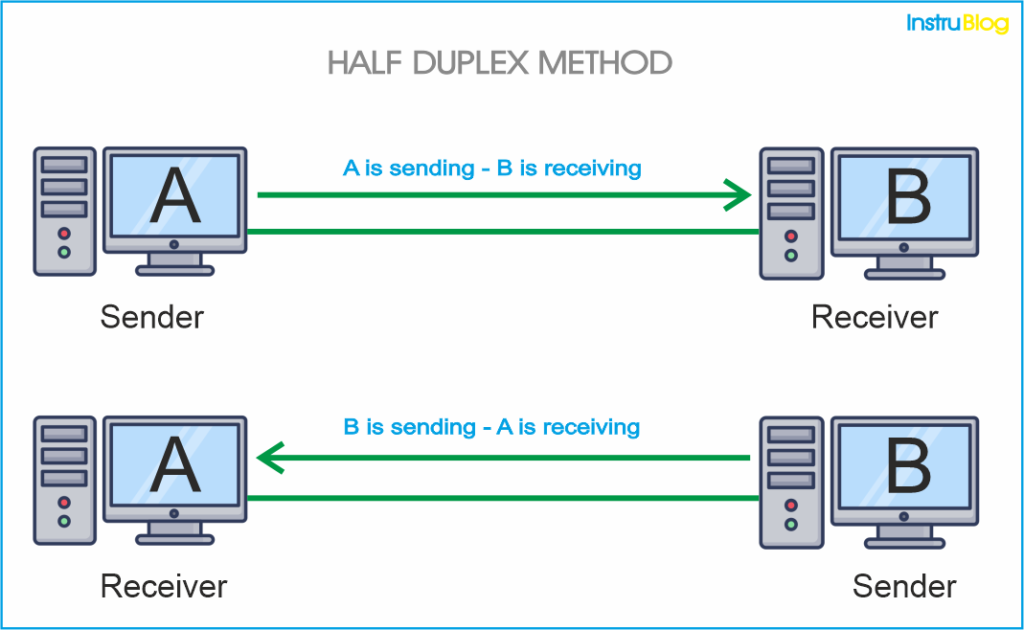
In the Half Duplex method, both the sender and receiver have the capability to transmit data, but not simultaneously. When one device is sending data, the other device can only receive, and vice versa.
This method is commonly used in devices or systems where there is no requirement for simultaneous communication in both directions.
A popular example of the half-duplex method is the use of walkie-talkies, where users take turns speaking and listening. Another example is the internet, where communication between a client (such as a laptop) and a web server occurs in a half-duplex manner.
The client sends a request for a web page, and the server processes the request and sends back the requested information.
Full Duplex Method
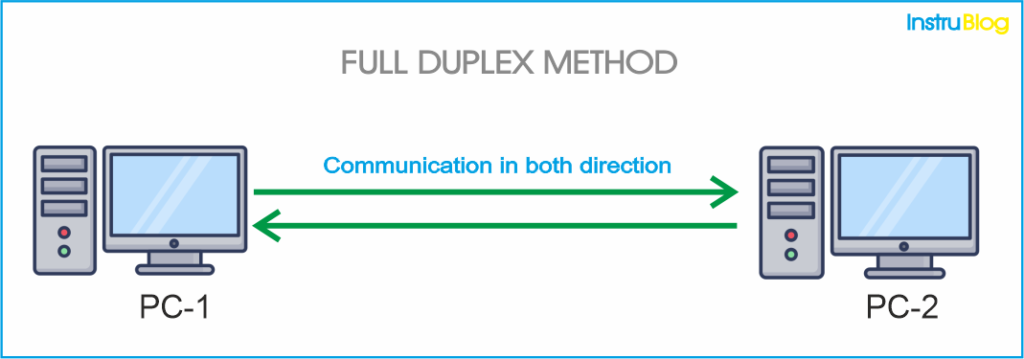
In the Full Duplex method, both the sender and receiver have the ability to transmit and receive data simultaneously.
This method is used when continuous communication in both directions is required. Devices or systems that rely on real-time, bi-directional data exchange often employ full-duplex communication.
A common example of the full-duplex method is smartphone communication. When making a phone call, both parties can speak and listen simultaneously, allowing for smooth and uninterrupted conversation.
Types of Data Transmission
Data transmission can occur through two methods: Serial Communication and Parallel Communication.
Serial communication involves sending data one bit at a time using only two wires. This method is commonly used when there is a need for long-distance transmission or limited resources.
On the other hand, parallel communication transfers multiple bits of data simultaneously. It utilizes multiple wires, typically 8, 16, or 32, to transmit data in parallel. Parallel communication is commonly used for short-distance communication or when high-speed data transfer is required.
Both serial and parallel communication have their advantages and are suitable for different applications depending on factors such as distance, speed, and resource availability.
Difference between Serial and Parallel communication
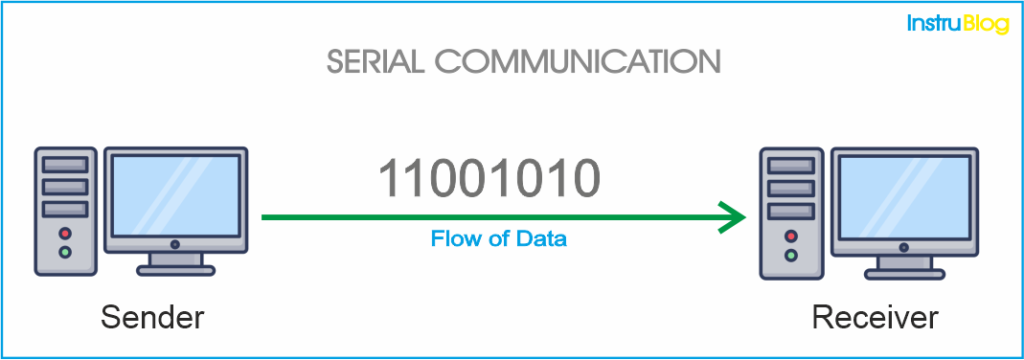
Serial communication, where one bit is transmitted at each clock pulse, offers several advantages.
Firstly, it requires fewer input-output lines compared to parallel communication. This leads to a reduction in the number of wires required, making it more space-efficient and compact.
Secondly, serial communication exhibits better resistance to cross-talk, which is the interference between different signal lines. With fewer wires, the chances of cross-talk and signal degradation are minimized.
Moreover, the overall cost of the system is typically lower with serial communication due to the reduced number of wires and components needed.
These factors make serial communication well-suited for long-distance communication, where cost-efficiency, space-saving, and resistance to signal interference are crucial considerations.
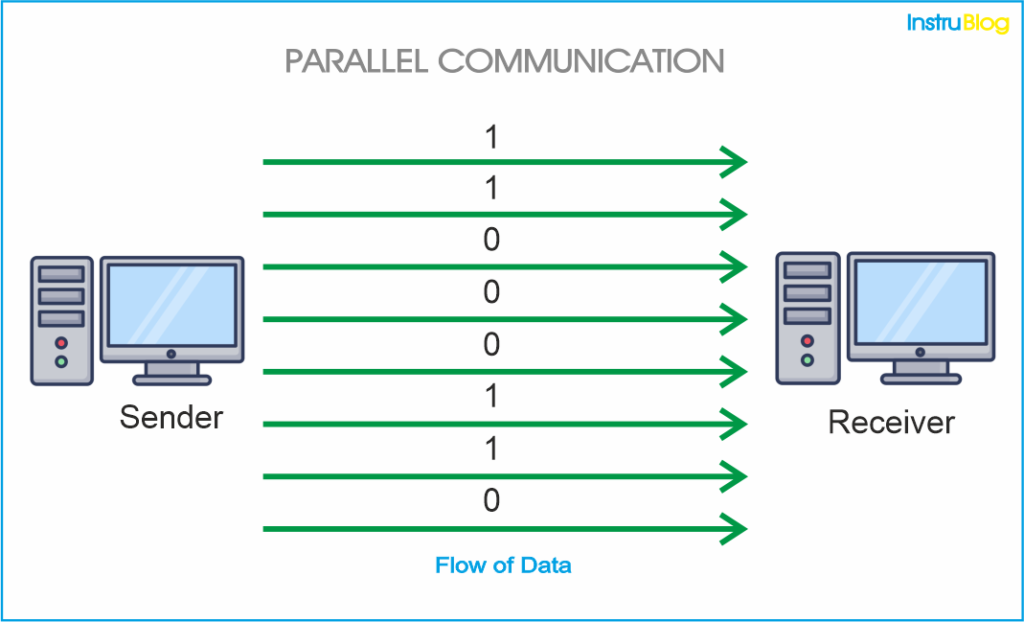
Parallel communication involves the simultaneous transmission of multiple bits (such as 8, 16, or 32 bits) together. In this method, each bit of data requires its own dedicated physical input-output line.
The main advantage of parallel communication is its speed. Since multiple bits are transmitted simultaneously, the data transfer rate is higher compared to serial communication.
However, a drawback of parallel communication is the requirement for a greater number of input-output lines. Each bit of data needs its own separate line, resulting in a larger number of physical connections.
While parallel communication offers faster data transfer, the increased complexity and higher number of lines can make it more challenging to implement and maintain, especially in situations where space is limited or when long-distance communication is involved.
| Features | Serial Communication | Parallel Communication |
|---|---|---|
| Data Transmission | Sends data bit by bit at one clock pulse | Transfers a chunk of data at a time |
| Number of Lines | Requires one wire to transmit the data | Requires ‘n’ number of lines for ‘n’ bits |
| Communication Speed | Communication speed is low | Communication speed is fast |
| Installation Cost | Installation cost is cheaper | Installation cost is higher |
| Distance Preference | Preferred for long-distance communication | Used for short-distance communication |
Clock Synchronization
In order to ensure efficient communication with serial devices, the synchronization of clocks is crucial. Clock signals play a vital role in serial communication, and there are two main types: synchronous transmission and asynchronous transmission.
Synchronous Transmission
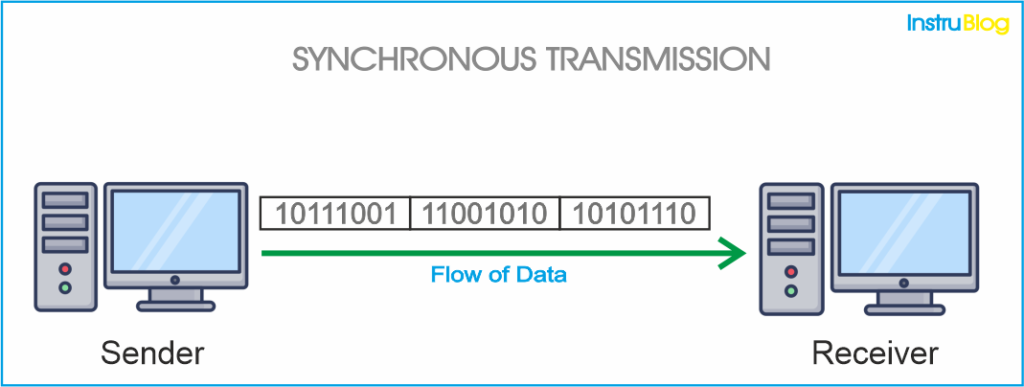
In synchronous transmission, data is sent in the form of blocks or frames, rather than individual bits. This type of transmission is considered full-duplex, meaning that data can be transmitted in both directions simultaneously.
One key requirement in synchronous transmission is synchronization between the sender and receiver. This synchronization ensures that the data is properly organized into blocks or frames, and both devices are operating in harmony. Without synchronization, the transmission may be prone to errors or data loss.
One advantage of synchronous transmission is that there is no gap present between data. This continuous stream of data allows for more efficient and reliable transfer of a large amount of information. By sending data in blocks or frames, it reduces overhead and improves the overall efficiency of the transmission process.
Asynchronous Transmission
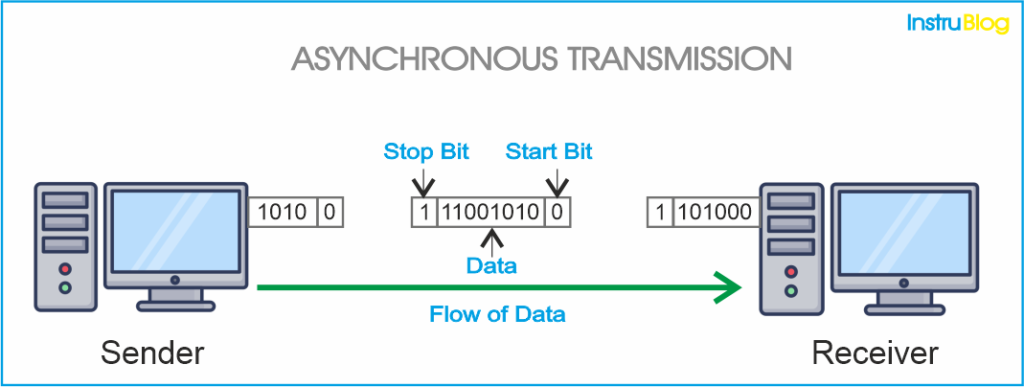
In asynchronous transmission, data is sent in the form of individual bytes or characters, rather than blocks or frames. This type of transmission is considered half-duplex, meaning that data can only be transmitted in one direction at a time.
In asynchronous transmission, each byte or character is accompanied by start bits and stop bits. These additional bits are used to indicate the beginning and end of each data unit and ensure proper synchronization between the sender and receiver. Unlike synchronous transmission, asynchronous transmission does not require continuous synchronization between devices.
One advantage of asynchronous transmission is its simplicity and flexibility. The start and stop bits allow for easy identification and separation of data units, making it suitable for applications that involve transmitting smaller chunks of data.
However, asynchronous transmission typically has lower transmission speeds compared to synchronous transmission. The overhead of adding start and stop bits to each data unit reduces the overall efficiency of the transmission process.
Parameters for Serial Communication
1 What is the Baud rate?
Baud rate, measured in bits per second (bps), determines the speed at which information is transferred between a sender and a receiver in serial communication. It represents the number of signal changes per second.
When implementing serial communication, it is crucial to set the same baud rate on both the sender and receiver sides to ensure proper synchronization and data transfer. Both devices must be configured to operate at the same speed to establish successful communication.
Commonly used standard baud rates include 1200, 2400, 4800, 9600, and 57600 bps, among others. The selection of the baud rate depends on factors such as the capabilities of the devices involved and the desired data transfer speed.
By setting the baud rate to the same value on both the sender and receiver, they can establish a synchronized communication link and effectively transfer information between each other.
2 Framing
Framing in serial communication refers to the grouping of data bits that are transmitted from a sender to a receiver. It involves dividing the data into distinct units or frames, typically consisting of a fixed number of bits.
In most cases, a commonly preferred framing configuration is using 8 bits for each data frame. This means that the data to be transmitted is organized into groups of 8 bits before being sent from the sender device to the receiver device. This 8-bit configuration is often referred to as an 8-bit frame or byte.
The choice of using 8 bits for framing is based on factors such as compatibility, ease of implementation, and the widespread usage of 8-bit data representation in various systems and protocols.
By employing a consistent framing structure, both the sender and receiver can properly interpret and process the transmitted data, ensuring reliable and accurate communication between the devices.
3 Synchronization
In asynchronous serial communication, the framing of data includes the use of start and stop bits. There are 1 start bit and 1 or 2 stop bit in the framing from the transmitter ends. These bits help indicate the beginning and end of each data frame being transmitted from the sender to the receiver.
At the start of each data frame, a single start bit is transmitted by the sender. This start bit serves as a signal to the receiver, indicating the start of the data transmission. It allows the receiver to synchronize itself with the incoming data stream.
Following the start bit, the actual data bits of the frame are transmitted. The number of data bits in each frame can vary but is commonly set to 8 bits. These data bits carry the actual information to be transmitted.
After the data bits, one or two stop bits are transmitted. The purpose of the stop bit(s) is to indicate the end of the data transmission for that particular frame. It provides a brief period of idle time before the start of the next frame.
4 Error Control
Error control is an important aspect of serial communication that helps identify and handle errors in transmitted data. It involves the use of parity checks, which are mechanisms to detect errors during data transmission. There are three commonly used types of parity checks: even parity check (EVEN), odd parity check (ODD), and no parity check (NONE).
In even parity check, an additional bit, known as the parity bit, is added to the transmitted data. The value of this parity bit is chosen in such a way that the total number of ones in the data and parity bit combined becomes an even number. The receiver performs the same calculation and compares the received parity bit with the calculated value. If they don’t match, it indicates that an error has occurred during transmission.
Similarly, in odd parity check, the parity bit is chosen in a way that the total number of ones in the data and parity bit combined becomes an odd number. The receiver performs the same calculation and checks for a match to detect errors.
On the other hand, with no parity check, no additional parity bit is added to the transmitted data. The receiver does not perform any parity calculation, and errors are not detected through parity checks. This method is useful when error detection is not a primary concern or when error correction techniques are implemented at higher protocol layers.
Summary
Serial communication plays a crucial role in various fields, including electronics and computers. When implementing serial communication, it is necessary to configure certain parameters in both the sender and receiver to ensure successful data transmission.
One of the key parameters to set is the baud rate, which determines the rate at which data is transmitted. Baud rate represents the number of signal changes per second and needs to be consistent between the sender and receiver to establish proper communication.
Framing refers to the structure of the transmitted data, including the number of bits per character, start and stop bits, and the order of transmission. It is important to configure the framing settings correctly to ensure accurate data interpretation on both ends.
Parity is another setting that can be implemented to add error detection capabilities. Parity bits are added to the transmitted data to detect and potentially correct transmission errors. Choosing the appropriate parity scheme (such as even, odd, or none) is essential for maintaining data integrity.
By configuring baud rate, framing, and parity settings accurately in both the sender and receiver, the serial communication system can establish reliable and efficient data transmission.
If you have any further questions or need clarification on any aspect of serial communication, please feel free to ask in the comment section below.
I hope you like above blog. There is no cost associated in sharing the article in your social media. Thanks for reading!! Happy Learning!!
Related Article : What are the different types of Communication Protocols?

